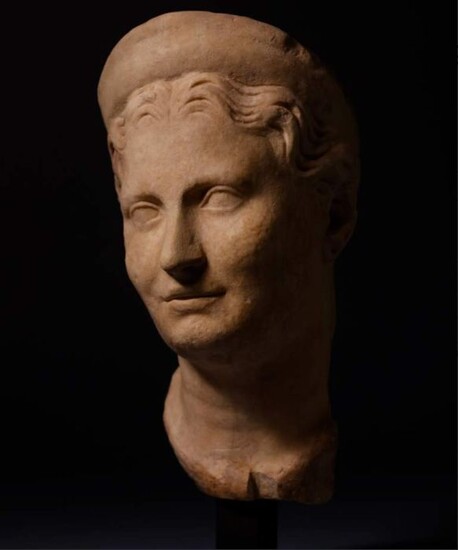Ancient Roman Marble Stunning Head of a Roman Matron wearing a diadem. Trajan or Hadrian Period 98-138 AD. 35 cm H.
Stunning Head of a Roman Matron wearing a diadem. Trajan or Hadrian Period 98-138 AD. 35 cm H. - 19 kg - Material: Pentelic marble Dimensions: 35 cm Height without stand. Condition: Restorations to nose, chin and diadem. Holding the title of "matron" in Ancient Rome was a sign of a certain status. A matron was a woman with a certain amount of distinction. She was freeborn and usually either married or a widow. The status of Matron was a powerful concept to reference, but not a static one. There were some concrete markers of this status, especially in terms of clothing. During the late Republic and throughout the time of the Empire a matron generally wore two tunics covered by a long dress known as a stole. When she went out she would add a palla, a mantle draped over the shoulders and sometimes over the head as well. Young girls, prostitutes, and those who had forfeited the title of matron (usually through being caught in adultery) were not permitted to wear either of these garments. Though matrons were generally expected to occupy themselves with running their households, as a group they also granted various honors and responsibilities on certain occasions and could get their voices heard in ways other women could not. A Vestal Virgin who fell seriously ill would be given into the care of some well-respected and wealthy matron. One of the reasons Hortensia and the women who accompanied her were listened to was because they were respected matrons. An adultery conviction was the most obvious way to lose the title of matron, but there were other reasons. Cicero argued that to use the title "matron" with any connection to Clodia, whom he accused of poisoning and seduction was the height of impropriety. Concubinage, however, seems not to have necessarily caused a woman to forfeit the title of matron. The jurist Ulpian, at least, argues that a concubine's patron can only accuse her of adultery as a third party and then only if she has not already forfeited the name of matron. So perhaps the title of matron and the ideal behind it had some flexibility, at least by the 2nd century CE. Provenance: - Old Parisian collection, 1960 - 1970. - From a Judiciary sale, Paris, 2021. With French Cultural Passport. Notes: The seller guarantees that he acquired this piece according to all national and international laws related to the ownership of cultural property. Provenance statement seen by Catawiki. - The piece includes authenticity certificate. - The piece includes Spanish Export License. #breakthebias2022
[ translate ]View it on
Estimate
Time, Location
Auction House
Stunning Head of a Roman Matron wearing a diadem. Trajan or Hadrian Period 98-138 AD. 35 cm H. - 19 kg - Material: Pentelic marble Dimensions: 35 cm Height without stand. Condition: Restorations to nose, chin and diadem. Holding the title of "matron" in Ancient Rome was a sign of a certain status. A matron was a woman with a certain amount of distinction. She was freeborn and usually either married or a widow. The status of Matron was a powerful concept to reference, but not a static one. There were some concrete markers of this status, especially in terms of clothing. During the late Republic and throughout the time of the Empire a matron generally wore two tunics covered by a long dress known as a stole. When she went out she would add a palla, a mantle draped over the shoulders and sometimes over the head as well. Young girls, prostitutes, and those who had forfeited the title of matron (usually through being caught in adultery) were not permitted to wear either of these garments. Though matrons were generally expected to occupy themselves with running their households, as a group they also granted various honors and responsibilities on certain occasions and could get their voices heard in ways other women could not. A Vestal Virgin who fell seriously ill would be given into the care of some well-respected and wealthy matron. One of the reasons Hortensia and the women who accompanied her were listened to was because they were respected matrons. An adultery conviction was the most obvious way to lose the title of matron, but there were other reasons. Cicero argued that to use the title "matron" with any connection to Clodia, whom he accused of poisoning and seduction was the height of impropriety. Concubinage, however, seems not to have necessarily caused a woman to forfeit the title of matron. The jurist Ulpian, at least, argues that a concubine's patron can only accuse her of adultery as a third party and then only if she has not already forfeited the name of matron. So perhaps the title of matron and the ideal behind it had some flexibility, at least by the 2nd century CE. Provenance: - Old Parisian collection, 1960 - 1970. - From a Judiciary sale, Paris, 2021. With French Cultural Passport. Notes: The seller guarantees that he acquired this piece according to all national and international laws related to the ownership of cultural property. Provenance statement seen by Catawiki. - The piece includes authenticity certificate. - The piece includes Spanish Export License. #breakthebias2022
[ translate ]


